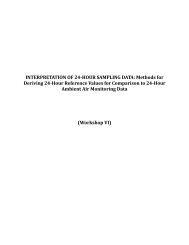Outdoor Wood-Fired Boilers - Alliance for Risk Assessment
Outdoor Wood-Fired Boilers - Alliance for Risk Assessment
Outdoor Wood-Fired Boilers - Alliance for Risk Assessment
Create successful ePaper yourself
Turn your PDF publications into a flip-book with our unique Google optimized e-Paper software.
Low Wind Speeds – The Cincinnati area is in the Department of Energy’s lowest<br />
category <strong>for</strong> wind energy potential. These low average wind speeds mean that air<br />
contaminants tend to disperse less rapidly than in areas that have average or high wind<br />
speeds.<br />
Hilly Terrain – The Cincinnati area includes many locations with steep slopes. This<br />
increases the chances that a nearby receptor will be at a higher elevation than the top of<br />
an OWBs smokestack, and will there<strong>for</strong>e experience a greater concentration of air<br />
contaminants than a receptor at a lower elevation.<br />
High Asthma Rates – Rates of asthma and other respiratory conditions fluctuate by<br />
neighborhood in Cincinnati, and substantially exceed the national average in some<br />
neighborhoods. This increases the chance that an especially sensitive individual will be<br />
among the nearby receptors of OWB emissions.<br />
Poor Air Quality – Cincinnati is a non-attainment or borderline attainment area <strong>for</strong> PM<br />
2.5 and Ozone under the Clean Air Act. In addition, EPA modeling indicates that excess<br />
cancer risks due to inhalation of air toxics in the outdoor air range from 3 per 100,000 to<br />
more than 20 per 100,000. These background levels of exposure to air pollution may<br />
make individuals more sensitive to the additional burden imposed by a nearby OWB.<br />
Multiple Sources – Many Cincinnati neighborhoods are in close proximity to<br />
manufacturing industries that may have intermittent emissions of airborne chemicals.<br />
These emissions may meet single source emission standards but have synergistic adverse<br />
effects when combined with the high local concentrations of chemicals near OWB<br />
smokestacks.<br />
Multi-Family Housing – There is a high concentration of apartment buildings in the city,<br />
with variable placement of air intake vents. Positioning of an OWB near an air intake<br />
vent <strong>for</strong> an adjacent apartment building has potential to spread toxic fumes to a large<br />
number of individuals.<br />
Lack of Regulation – Current, Cincinnati has no regulations that require catalytic<br />
converters or other emissions cleansing devices <strong>for</strong> OWBs.<br />
Quantification of the impacts of these factors on OWBs is beyond the scope of this<br />
report.<br />
Acknowledgements:<br />
The authors appreciate the endorsement of the <strong>Alliance</strong> <strong>for</strong> <strong>Risk</strong> <strong>Assessment</strong> (ARA) and<br />
the support of Larry Falkin of the City of Cincinnati Office of Environmental Quality in<br />
the initiation of this work. Internal resources of Toxicology Excellence <strong>for</strong> <strong>Risk</strong><br />
<strong>Assessment</strong> (TERA) were used to develop this report.<br />
Toxicology Excellence <strong>for</strong> <strong>Risk</strong> <strong>Assessment</strong> (TERA)<br />
<strong>Outdoor</strong> <strong>Wood</strong>-<strong>Fired</strong> <strong>Boilers</strong>: A Synopsis <strong>for</strong> Urban Use<br />
16





